To read the news over the past few years was to believe that fashion, as both a concept and an industry, had officially given up the ghost. In 2020, the sector posted an unprecedented 93 percent decline in economic profit—the worst year on record—according to the McKinsey Global Fashion Index. First Barneys declared bankruptcy, then Neiman Marcus. Viral stories like “Sweatpants Forever,” in The New York Times—which proclaimed that “even before the pandemic, the whole fashion industry had started to unravel”—read like obituaries for a world in which big-name designers influenced style or set trends. The premise seemed to make sense: Who needs couture gowns, or even trousers with a button, when you spend your Saturday nights doom-scrolling on the sofa while half-watching Netflix? But there was one problem with that logic: Fashion has never been in any way logical. And so, even as waves of the pandemic continue to crest and crash around the globe, a new generation of audacious creators is sewing up some of the most dramatic, over-the-top looks to grace runways—or, more accurately, fill Instagram grids—in decades. There are wire-framed nautilus dresses without armholes; nipple-baring corsets; hats as big as dinner tables; and frocks voluminous enough to double as temporary housing, complete with tent poles.
“Right now, there’s a craving for fantasy,” says 25-year-old Harris Reed, the designer behind both Harry Styles’s instantly iconic stage ensembles and Iman’s scene-stealing 2021 Met Gala look, which was less a dress than an ambulatory metal cage embellished with gold feathers and topped with a headpiece stretching six feet in circumference. (Reed, who accompanied her, wore a matching hat, of course.) “We’ve had 30 years of fashion getting more and more subtle,” says the London-based L.A. native, who speaks so quickly and enthusiastically that he almost seems to levitate. “I think it’s time now to splash out and bring back the era of performative clothes that have a message! Bring back the avant-garde!”
.
CHET LO
“Everyone thinks that my work is digital, that I Photoshopped everything. But the thing that I love about it is that it is real,” says Chet Lo. “Whenever I put on my own clothes, I’m just running my hands up and down my body, because they feel so tactile.”
Mayor wears a Chet Lo swimsuit, headpiece, pool noodle, arm guards, and sandals.
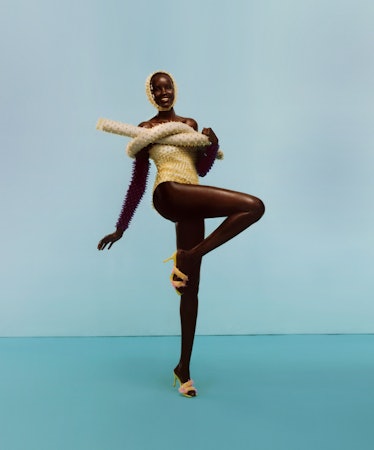
Though best known for dressing celebrities, Reed, who has collaborated with Dolce & Gabbana, and was an intern and a model at Gucci, is very much his own muse. “My brand came from me dressing myself: a gender-fluid person who is six foot four, and in platforms, seven foot five,” he says. “I needed flares that billow out! I needed a bow! I needed a hat! And then I found this huge market that I didn’t even know existed.”
Though perhaps prone to a bit of exaggeration, Reed is not kidding about the market. Despite the continued dearth of occasions for which to dress up, his deliciously melodramatic designs, he says, are flying off the mannequins. “The dress from my last collection that was this huge gown, modeled on a male-identifying model, with this huge hat, sold the first day it went in the window at Selfridges for over $12,000. And everyone was like, No one is going to buy that! We’re in a pandemic! Where are they wearing that? But we’ve had nothing but loads of people wanting a re-creation.”
His friend Chet Lo, a Chinese-American designer who is inspired by retro-futuristic anime, and who does candy-colored, spiked knitwear that looks like a cross between sea creatures and exotic fruit, tells a similar story. “When I first started making these jumpers, I didn’t think they were going to sell, because they’re, like, insane,” says Lo, who grew up in New York and, like Reed, now works out of a studio at the Standard hotel in London. He attributes their popularity—Doja Cat, SZA, and Kylie Jenner have all been spotted in his surreal knits—at least in part to his creative purity. “People can really feel authenticity,” he says. “They can tell when you’re trying to make something just to sell, and when you’re doing something because you want to do it.”
.
BRADLEY SHARPE
“We’re living in times when people are struggling,” says Bradley Sharpe, “so the goal now is to create pieces that really speak to people and make them feel something deeply.”
Manase wears a Bradley Sharpe gown and headpiece; Hasuvanakit shoes; stylist’s own tights.

It’s no surprise that Reed and Lo—as well as many of the other young designers producing wildly creative collections right now—are recent grads of the fashion program at London’s Central Saint Martins, a school known for turning out boundary-breaking artistes like Alexander McQueen and John Galliano, and for pushing back against the notion that fashion is in any way a commercial enterprise. “They really encourage you to do whatever comes into your brain,” says Lo, who graduated with Reed in 2020.
For Chelsea Chie Kaya, who graduated from Saint Martins in 2021 and is now working on her master’s, that meant concentrating her undergraduate research on the artist Christo—who famously swathed everything from buildings to islands in giant bolts of cloth—rather than mining designer archives or looking to old runway photos for inspiration. Her graduate collection, under the label Kaya Chie, features a variety of fabrics stretched and ruched over sharp-edged, wildly asymmetrical forms. (Think one giant shoulder, a bat-wing hip, half a bustle…) “Looking at Christo gave me this idea of wraps, and a lot of tension created on a structure,” says Kaya, who grew up in Tokyo and Shanghai, and now lives in London.
Her classmate Bradley Sharpe is turning out equally sculptural work. The 26-year-old Brit, who did a stint at Marc Jacobs before launching his collection, found his creative spark in the unlikely overlap between 18th-century Marie Antoinette–style silhouettes and the camping tents that crowd the muddy fields at the music festivals he frequents with his friends. For his graduate collection, he used actual tent poles to build futuristic ball gowns large enough to shelter a small family—or at least a few Gen Z–ers waiting out the rain at Glastonbury. “I just can’t think small,” says Sharpe, who sees the massive pieces he and his peers are producing as the ultimate antidote to fast fashion. “I’ve always seen clothes as an art form, not something to be worn and put in the wash and worn another time and then thrown away. The bigger a piece is, the more respect you have for it. If you buy a blazer, you can just put it in your closet; but to have one of these gowns, you almost have to build a closet for it.”
.
FEBEN
“Growing up in Sweden, I remember being embarrassed of how my Ethiopian mother dressed, because it was very different from the Scandinavian clean-cut look,” says Feben. “But now I get most of my research done when I go back to my mother’s house and look at old photo albums.”
From left: Celina Ralph wears a Feben dress and gloves; stylist’s own hat. Mayor wears a Feben jumpsuit and bag; stylist’s own hat.

That’s a sentiment echoed by many of the designers creating these one-of-a-kind, hugely labor-intensive looks. Many of them, points out Feben Vemmenby—another 2020 Saint Martins grad, who goes by Feben—started their labels while on lockdown, when the global pace of life slowed enough for them to think long and hard about the perils of mass consumption. “We had more time to evaluate who we are as people and how we shop,” says Feben, who was born in North Korea to Ethiopian parents and raised in Sweden. Reed puts it more bluntly. “No more quick, cheap crap!” says the designer, who works exclusively with one client a month, creating custom looks that involve weeks of intricate handiwork. “Everyone says get your stock list and make 50 blouses and 50 dresses and 50 vests, and I was just like, ‘Fuck all of that! I’m making one huge feathered headpiece with upcycled crystals and lace, and that’s how I’m going to structure my business.’ And it’s proven really fabulous.” While he has recently launched a small collection of what he describes as “yummy cashmere fluid basics” with Bergdorf Goodman and MatchesFashion—“It was my way of not having to do a ready-to-wear line”—his focus is on demi-couture creations, which, he says, are meant to be “passed down from a grandmother to a trans son to their nonbinary daughter. It’s about bringing back that 360-degree cycle of beauty to the world.”
To hear many of these designers tell it, the pandemic made them think not only more sustainably, but also more fantastically. Trapped alone in their apartments, they found it hard not to dream about the big fancy social events that had been canceled. And after a few months of embracing the cozy, weren’t we all ready to torch our microfleece wardrobes? According to fashion historian Valerie Steele, the director and chief curator of the Museum at FIT in New York, the cadre of what she describes as “kids doing big, voluminous clothes” might simply be the result of fashion’s perpetual pendulum. “Fashion is reactive to what the previous fashion was,” she says. “It works in silhouettes, it works in colors, and it works in relative modesty or flamboyance.”
.
KAYA CHIE
“Designing this collection during Covid, I just felt this urge to attend a normal evening event,” says Chelsea Chie Kaya, “to wear something glamorous, a more exaggerated dress.”
Ralph wears a Kaya Chie dress, scarf, and shoes; stylist’s own tights.

That makes sense. But perhaps the greatest driver of this return to radical, OTT style is, as with pretty much every trend of the current millennium, the Internet. These dramatic, eye-popping, highly photographable garments were truly made for digital life—figuratively and, in some cases, intentionally. “The way that you present yourself online is such a big part of who you are now,” points out Lo. “It’s a very young way of thinking: ‘Let me take a picture of myself in some cool work.’ That’s how the interest in my work started, and we rode that wave. A lot of times, people would look at my stuff and say, ‘Oh, that’s really photogenically cool, but where am I going to wear it?’ But they do want pictures taken in these clothes.”
The importance of one’s digital presentation, of course, increased exponentially during the pandemic. “There was a huge shift from the physical world to the virtual world,” points out Terrence Zhou, a New York–based native of Wuhan, China, who graduated from Parsons last year. As a designer of deeply trippy, hugely impractical statement wear, he says that change of focus was actually quite liberating. “When I was in school, I was always challenged because everyone would say, ‘How are people going to wear your clothes? They can’t go to work or a party with no armholes!’ ” he says. “But they like to post them online. It’s a different context, but one that is just as relevant. Now, with the Internet and technology, we can free ourselves and express even more of our personalities, rather than just be limited to functional garments.”
.
HARRIS REED
“I think the pandemic made us dream bigger and crave that level of avant-garde,” says Harris Reed. “People want a massive, larger-than-life hat that maybe they didn’t want before.”
Ralph wears a Harris Reed gown and headpiece; stylist’s own gloves.
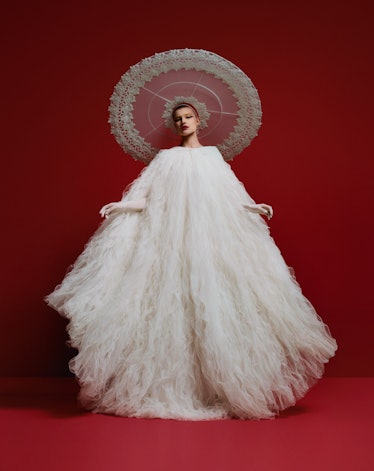
In Zhou’s mind, the next step is doing away with physical high fashion entirely. “I think people will be able to wear the digital version of clothing in the future,” says Zhou, who is already thinking about virtual production of his work, a sort of fashion version of an NFT that would do away with many of the issues nagging at the collective conscience of capitalism these days. “If we move to a virtual design, we can be creative with no restrictions,” he says. “There won’t be wasteful fabric to think about, and we won’t have to contend with things like sweatshops.” And at a time when mass retailers regularly rip off the work of up-and-coming creators with no consequences, “a designer’s intellectual property is protected in the virtual world in a way that is ignored in real life,” he points out. “So for me, this is very exciting.”
But, of course, not every 20-something designer is ready to trade in their pincushion for a mouse pad. “Digital garments are great for a picture, but you lose something in that,” Reed says. “I think it’s so beautiful to see my friends in stuff that they’ve made, being able to touch it and admire the handiwork and know that it took 80 hours to make. That blood, sweat, and tears will never be erased.” Sharpe agrees: “My perception of fashion is a group of people sitting in a circle, hand-sewing,” he says. “That’s it for me.”
.
TERRENCE ZHOU
“When we think about fashion, it’s all tied up with the concept of functionality,” says Terrence Zhou. “But now, with the Internet and technology, we can free ourselves and express even more of our personalities, rather than just be limited to functional garments.”
From left: Ikechukwu wears a Terrence Zhou dress; Christian Louboutin shoes; stylist’s own tights. Manase wears Bad Binch Tong Tong by Terrence Zhou pleated skirts; Saint Laurent by Anthony Vaccarello shoes; stylist’s own tights. Ndiaye wears a Bad Binch Tong Tong by Terrence Zhou hoop dress and pleated skirt; Tom Ford shoes; stylist’s own tights.

That doesn’t mean they aren’t reacting to the realities of our new world in other ways. Sharpe’s tent dresses and Reed’s flying saucer hats, for instance, are just the thing for enforcing social distancing—put one on, and it’s literally impossible to get within coughing distance of another human. The same applies to Marco Ribeiro’s “circles”—giant pleated rings of stiffened, brightly colored fabric that the Brazilian-born, Paris-based designer uses to various effect. Some are face-obscuring hats; others serve as exaggerated collars. “You see the circle but not who is behind it, so it is kind of a protection,” says Ribeiro, who says he felt the need for a sartorial shield even more as a Black man in an industry where he didn’t see himself represented. The wearable sculptures are also, he points out, visually arresting in the literal sense of the word. “They have the effect of a stop sign. You see the circle, and you have to stop to ask, ‘What is that?’ ”
Vincent Garnier Pressiat, a Paris-based alum of Maison Margiela and Balmain, who debuted his eponymous gender-fluid collection last year, is thinking along similarly defensive lines. “Now, if you go out, everyone is very afraid,” he says. “We are free in the digital world, and I just want to bring that outside. I want to give people the feeling of protection through my clothes.” For him, that translated into hard-edged tailoring, oversize cocoon silhouettes, and artfully shredded textiles—in other words, a wardrobe that seems designed for the looming apocalypse. “I wanted the clothes to be armor, for the wearer to feel strong, like a gladiator,” he says. The effect he was going for was “lasered, destroyed, like it’s been through the battle but is still here and still beautiful.”
That, if you think about it, doesn’t sound so different from what the fashion industry itself feels like these days.
.
MARCO RIBEIRO
“The circle is kind of a wall,” says Marco Ribeiro. “I’m not hiding myself, but it is a shield.”
Ikechukwu wears a Marco Ribeiro skirt and circle piece custom designed for the 2021 exhibition “Future Shock With Imruh Asha”; Marco Ribeiro bicolor tights; stylist’s own turtleneck; Hasuvanakit shoes.

Hair by Ali Pirzadeh at CLM Agency; makeup by Chiao Li Hsu at CLM Agency. Models: Celina Ralph at the Society Management, Evans Ikechukwu at Milk U.K., Goy Manase at PRM U.K., Mayor at Elite U.K., Momo Ndiaye at Supa U.K. Casting by Michelle Lee at Michelle Lee Casting. Set design by King Owusu. Movement director: Les Child at Streeters. Produced by Belinda Ford at Shiny Projects; production manager: Heather Robbins at CLM; junior producer: Mary Goughnour; photo assistants: Garth McKee, Wilbert Lati, Andy Broadhurst; fashion assistants: Naomi Philips, Harrison Beckett; hair assistants: Tommy Stayton, Anoushka Danielle; makeup assistant: Joshua Ventura; set assistant: John Langran; Covid officer: Vanessa Lewis Jones.
.
.
Originally posted from “W Magazine” by Jenny Comita

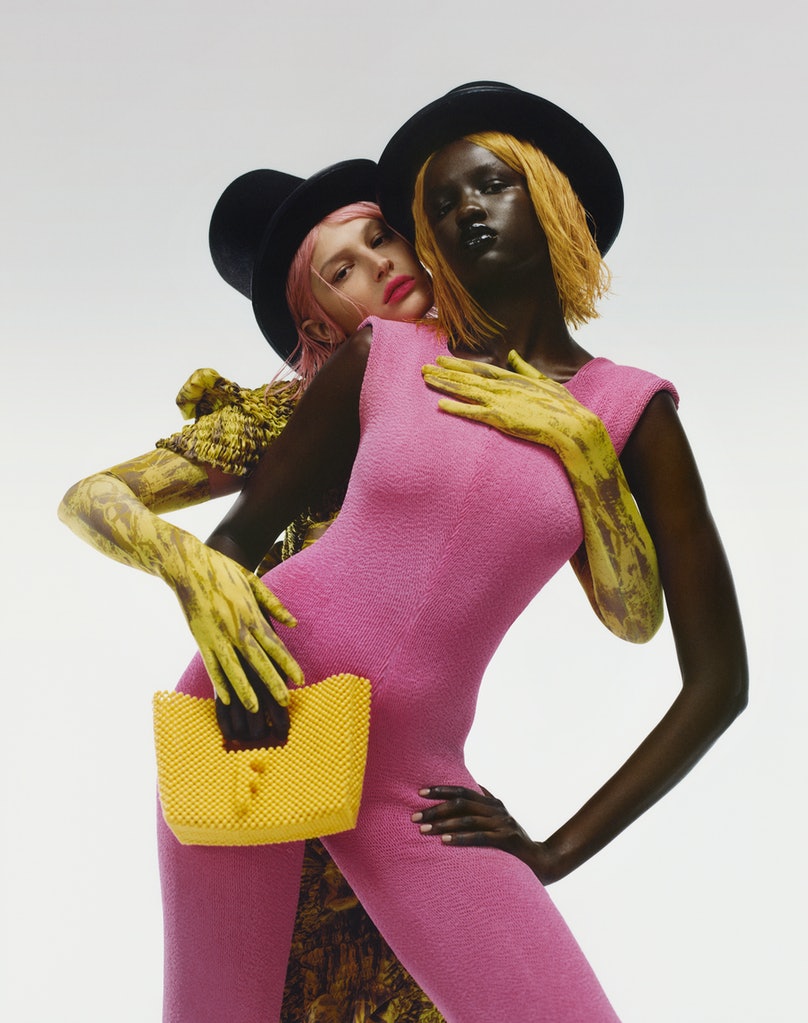
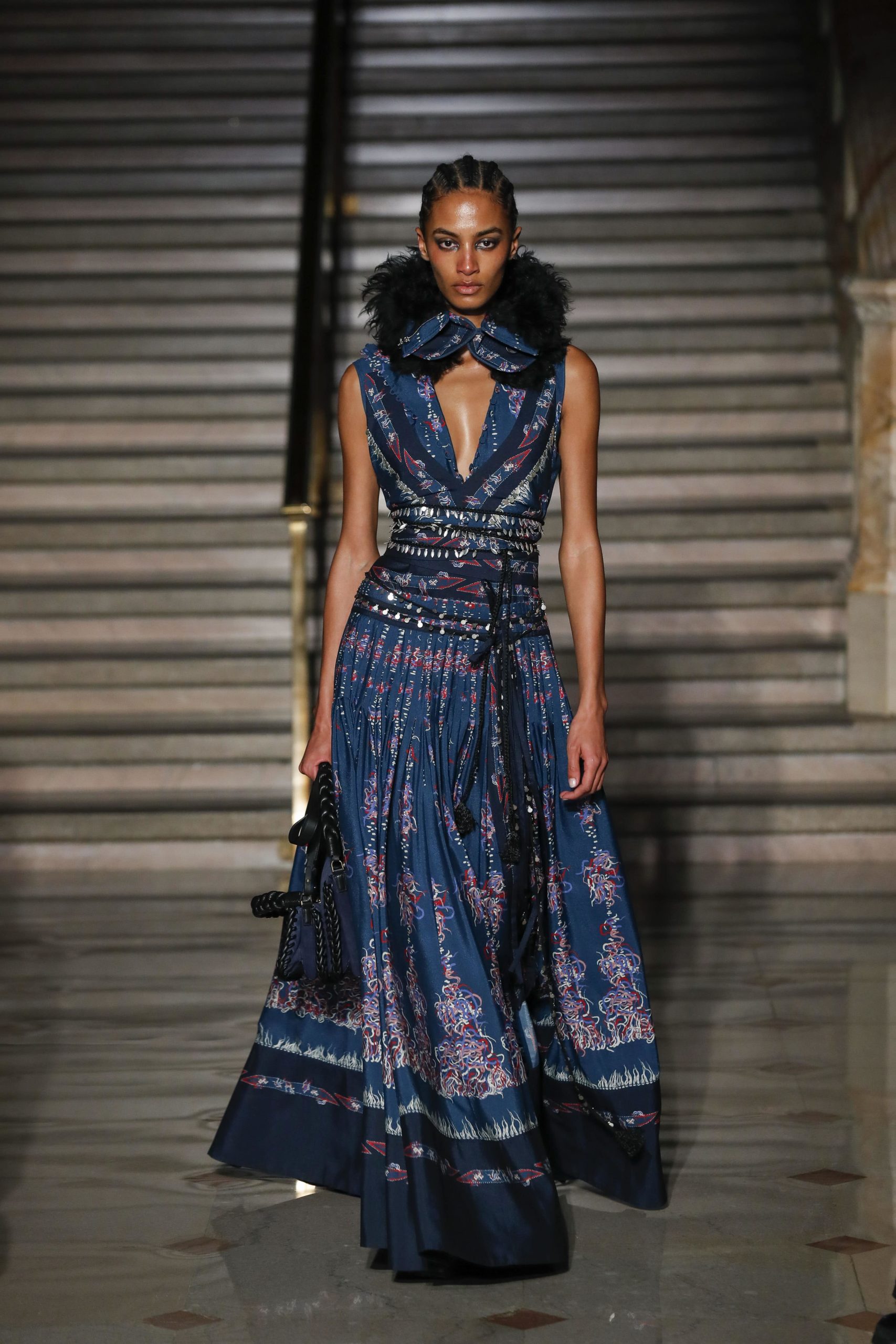
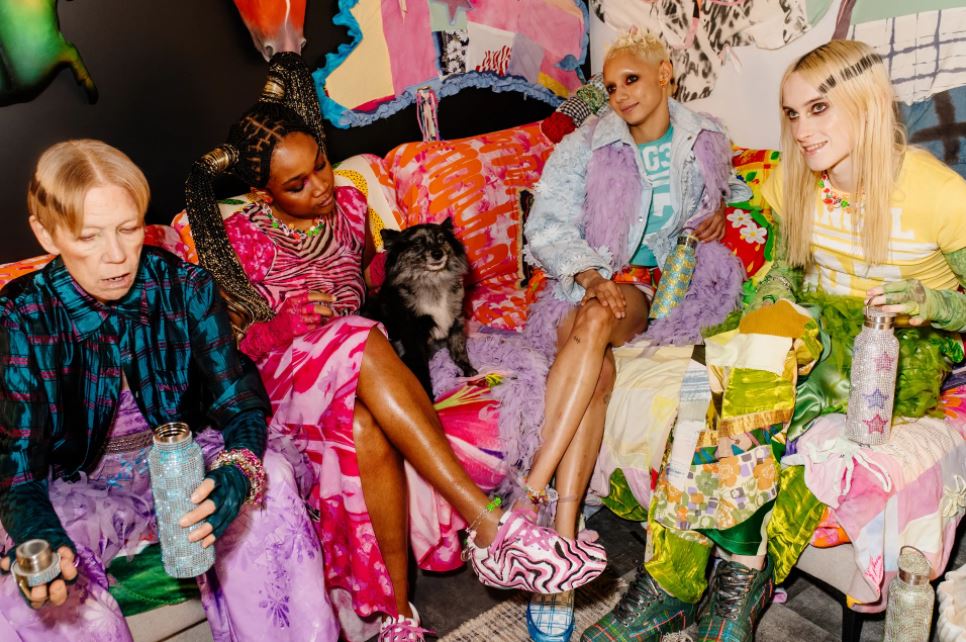
No Comments